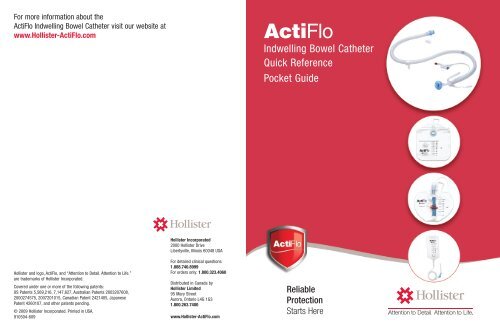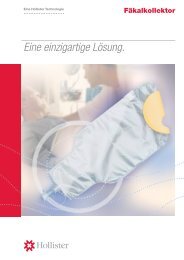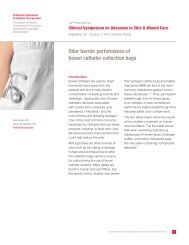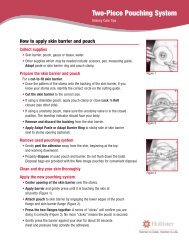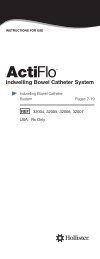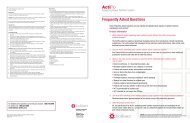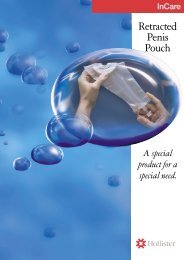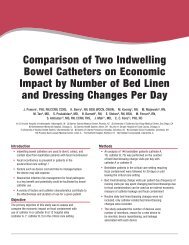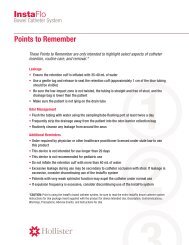ActiFlo - Hollister Incorporated
ActiFlo - Hollister Incorporated
ActiFlo - Hollister Incorporated
Create successful ePaper yourself
Turn your PDF publications into a flip-book with our unique Google optimized e-Paper software.
For more information about the<br />
<strong>ActiFlo</strong> Indwelling Bowel Catheter visit our website at<br />
www.<strong>Hollister</strong>-<strong>ActiFlo</strong>.com<br />
<strong>ActiFlo</strong><br />
Indwelling Bowel Catheter<br />
Quick Reference<br />
Pocket Guide<br />
<strong>Hollister</strong> and logo, <strong>ActiFlo</strong>, and “Attention to Detail. Attention to Life.”<br />
are trademarks of <strong>Hollister</strong> <strong>Incorporated</strong>.<br />
Covered under one or more of the following patents:<br />
US Patents 5,569,216, 7,147,627, Australian Patents 2003207608,<br />
2000274575, 2007201015, Canadian Patent 2421405, Japanese<br />
Patent 4260107, and other patents pending.<br />
© 2009 <strong>Hollister</strong> <strong>Incorporated</strong>. Printed in USA.<br />
910504-609<br />
<strong>Hollister</strong> <strong>Incorporated</strong><br />
2000 <strong>Hollister</strong> Drive<br />
Libertyville, Illinois 60048 USA<br />
For detailed clinical questions:<br />
1.888.740.8999<br />
For orders only: 1.800.323.4060<br />
Distributed in Canada by<br />
<strong>Hollister</strong> Limited<br />
95 Mary Street<br />
Aurora, Ontario L4G 1G3<br />
1.800.263.7400<br />
www.<strong>Hollister</strong>-<strong>ActiFlo</strong>.com<br />
Reliable<br />
Protection<br />
Starts Here
This Quick Reference Pocket Guide is only intended to highlight select<br />
aspects of catheter insertion, maintenance, and removal.*<br />
TABLE OF CONTENTS<br />
Patient Selection 4<br />
Considerations 4<br />
Contraindications 5<br />
Procedures 6<br />
Patient Preparation 6<br />
Catheter Insertion 6<br />
Catheter Maintenance 8<br />
Catheter Removal 9<br />
Routine Care Checklist 10<br />
Enema/Medication Administration 11<br />
Troubleshooting 12<br />
Odor Management 12<br />
Leakage 12<br />
Catheter Expulsion 12<br />
Ordering Information 13<br />
*CAUTION: Prior to using the <strong>ActiFlo</strong> Indwelling Bowel Catheter System, be sure<br />
to read the entire <strong>ActiFlo</strong> Indwelling Bowel Catheter System Instructions for<br />
Use package insert supplied with the product for device Intended Use, Description,<br />
Contraindications, Warnings, Precautions, Adverse Events, and Instructions for Use.<br />
2<br />
3
The <strong>ActiFlo</strong> Indwelling Bowel Catheter System is intended for diversion of<br />
fecal matter to minimize contact with the patient’s skin, to facilitate the<br />
collection of fecal matter for patients requiring bowel management, to<br />
provide access for colonic irrigation, and to administer enema/medications.<br />
Patient Selection<br />
Considerations<br />
The <strong>ActiFlo</strong> Indwelling Bowel Catheter is an option for fecal containment<br />
that requires a physician’s order. Examples of selection criteria<br />
may include:<br />
• Bowel incontinence, 2-3 loose/diarrhea stools a day<br />
• Bedridden patients unable to use a bedpan or commode<br />
• Patients who require rectally administered medications<br />
• Burns or donor sites likely to be contaminated<br />
• Infectious diarrhea<br />
• Prolonged sedation, mechanical ventilation, and/or use of paralytics<br />
• Wounds in or near the sacral or perianal area<br />
• Patients unable to tolerate frequent repositioning<br />
• Patient with urinary catheter or other lines at risk from<br />
fecal contamination<br />
• Not recommended for pediatric use<br />
• Not intended for use longer than 29 days<br />
Contraindications<br />
• Known sensitivities or allergies to the materials used in the device<br />
• Do not use if the distal rectum cannot accommodate the inflated volume of<br />
the retention cuff or if the distal rectum/anal canal is severely strictured<br />
• Impacted stool (disimpact before inserting the <strong>ActiFlo</strong> Catheter)<br />
• Recent (less than six weeks old) rectal anastomosis<br />
• Recent (less than six weeks old) anal or sphincter reconstruction<br />
• Compromised rectal wall integrity (e.g., ischemic proctitis)<br />
4<br />
5
Procedures<br />
Patient Preparation<br />
If appropriate, position on left side in knee-chest position. Clear the rectum<br />
of stool before catheter insertion. Based on digital exam of the anal canal,<br />
select appropriate catheter length (4 cm length fits most; the correct size<br />
provides a tension-free fit).<br />
Supplies<br />
• <strong>ActiFlo</strong> System Kit<br />
• Cup of water<br />
• Tape<br />
• Catheter tip syringe, 60 mL<br />
Catheter Insertion<br />
1. Connect end of catheter drain<br />
tube to collection bag.<br />
30<br />
20<br />
1 0<br />
CUFF<br />
35-40cc<br />
5. Fill retention cuff via BLUE<br />
connector with 35-40 mL of<br />
lukewarm water. Disconnect<br />
syringe.<br />
6<br />
2. Inflate intraluminal balloon via<br />
RED connector with 25 mL of<br />
air. Make sure the retention<br />
cuff is completely deflated<br />
(via BLUE connector).<br />
3. Generously apply water-soluble<br />
lubricant to the inflated intraluminal<br />
balloon, deflated retention cuff, anus,<br />
and anal canal. NOTE: To avoid<br />
damage to retention cuff or<br />
intraluminal balloon, DO NOT contact<br />
either with ANY sharp edge, including<br />
the enclosed lubricating jelly packets.<br />
4. Grasp the lubricated catheter at the<br />
distal edge of the retention cuff with<br />
catheter connector tubing oriented<br />
anteriorly to the patient. Insert the<br />
catheter.<br />
30<br />
20<br />
1 0<br />
6. Connect the syringe to the RED<br />
connector and completely aspirate<br />
the 25 mL of air from the intraluminal<br />
balloon. Disconnect the syringe and<br />
confirm the pilot balloon is fully<br />
collapsed. WARNING: Do not leave<br />
intraluminal balloon inflated in an<br />
unattended patient.<br />
7. Use a gentle tug and release<br />
to seat the retention cuff and<br />
confirm that the catheter fits<br />
tension-free. Confirm patency by<br />
irrigating using irrigation bag<br />
enclosed in kit (see Catheter<br />
Maintenance, step 3, page 8).<br />
8. Apply skin barrier (included in kit)<br />
to each buttock to help prevent tape<br />
injury. Tape the anchor straps on the<br />
skin barriers. If unable to use skin<br />
barrier or anchor straps, tape<br />
anchor straps smoothly to the<br />
<strong>ActiFlo</strong> Catheter.<br />
7
Catheter Maintenance<br />
Catheter Removal<br />
6 0<br />
55<br />
50<br />
4 5<br />
1. Frequently verify that the catheter<br />
and collection bag are positioned so<br />
the catheter drain tube is not<br />
twisted, kinked, or externally<br />
compressed. Apply gentle traction to<br />
“seat” the retention cuff. Frequently<br />
verify waste is not accumulating<br />
in the tube. To correct, strip the<br />
drainage away from the patient into<br />
the collection bag.<br />
1. Inflate intraluminal balloon via<br />
RED connector with 25 mL of air.<br />
8<br />
4 0<br />
2 5<br />
3 0<br />
3 5<br />
30<br />
2 0<br />
1 5<br />
1 0<br />
5<br />
20<br />
1 0<br />
CUFF<br />
35-40cc<br />
2. Flush the drainage tubing with tap<br />
water using the flush/sampling<br />
port at least twice a day. Repeat as<br />
needed to help decrease odor.<br />
3. Irrigate as ordered by connecting<br />
tubing from irrigation bag (included<br />
in kit and available separately) to<br />
CLEAR connector. WARNING: Verify<br />
connection to correct catheter<br />
connector. If appropriate for patient,<br />
position on left side in slight<br />
Trendelenburg position. Allow fluid<br />
to drain by gravity into the rectum.<br />
Use lukewarm water or saline (as<br />
prescribed by physician).<br />
4. Verify retention cuff volume at<br />
least every seven days. Connect<br />
syringe to BLUE connector<br />
completely aspirating all water.<br />
Refill retention cuff via BLUE<br />
connector with 35-40 mL of<br />
lukewarm water.<br />
2. Deflate catheter retention cuff<br />
by connecting syringe to the<br />
BLUE connector and slowly<br />
aspirating all water. Verify all<br />
water is removed by confirming<br />
the BLUE connector pilot balloon<br />
is collapsed.<br />
3. Grasp the catheter at the<br />
external retention faceplate, ask<br />
patient to bear down (if capable)<br />
and apply steady traction to<br />
remove the catheter. If the catheter<br />
does not come out relatively easily,<br />
apply water-soluble lubricant to<br />
the anal canal and repeat step<br />
2 and 3. Protect caregiver<br />
from splatter.<br />
9
Routine Care Checklist<br />
Every Shift<br />
Weekly<br />
Flush drainage tubing with tap water using<br />
flush/sampling port<br />
Irrigate patient via the CLEAR Connector (IRRIG/Rx)<br />
using 300 to 500 mL of lukewarm water or saline<br />
(as prescribed by physician) using the <strong>ActiFlo</strong><br />
Irrigation Bag. NOTE: Patients with very loose or<br />
watery stool may require less irrigation<br />
Frequently strip the drainage away from the patient into<br />
the collection bag. If leakage occurs, apply gentle<br />
traction to “seat” the retention cuff<br />
Verify intraluminal balloon is deflated<br />
Replace drainable collection bag<br />
Verify retention cuff volume<br />
Enema/Medications Administration<br />
1. Inflate the intraluminal balloon with 25 mL of air via the RED connector<br />
(STOP FLOW 25 mL air).<br />
2. Open the CLEAR connector (IRRIG/Rx) and flush the irrigation lumen<br />
with 20 mL lukewarm water.<br />
3. Connect the medication syringe or medication bag to the CLEAR<br />
connector (IRRIG/Rx) and slowly inject the solution or allow it to flow in<br />
by gravity. WARNING: Do not connect mechanical pumping devices<br />
to CLEAR connector (IRRIG/Rx).<br />
4. Flush the CLEAR connector (IRRIG/Rx) with 20 mL lukewarm water<br />
then close the connector.<br />
5. Allow the enema/medication to dwell for the desired retention time<br />
as prescribed by the physician.<br />
6. Using the syringe, completely aspirate the air from the intraluminal<br />
balloon via the RED connector (STOP FLOW 25 mL air). Disconnect<br />
the syringe and confirm the pilot balloon is fully collapsed.<br />
WARNING: Do not leave intraluminal balloon inflated in an<br />
unattended patient.<br />
10<br />
11
Troubleshooting<br />
Odor Management<br />
Flush the drainage tubing with tap water using the flush/sampling port at<br />
least twice a day. Cleanse the exposed end of the drainable collection bag<br />
spout before capping it. Change the drainable collection bags every seven<br />
days. Closed odor-barrier collection bags may also be used, and contain a film<br />
which is designed to control odor associated with stool. Routinely cleanse any<br />
leakage from around the anus.<br />
Leakage<br />
Make sure the intraluminal balloon is completely deflated and the retention<br />
cuff is inflated. Apply gentle traction to “seat” the retention cuff. Be sure<br />
the transsphincteric zone is not twisted, the anchor straps are secured, the<br />
tubing is straight and free of stool, and the drainage bag is lower than the<br />
patient. Placing the bed in a slight reverse Trendelenburg position will<br />
facilitate catheter drainage.<br />
During irrigation, if tolerated, position the patient in a slight Trendelenburg<br />
position. Avoid infusing irrigation too rapidly or using water that is too cool.<br />
Excessive leakage during use may be secondary to catheter occlusion with<br />
stool. Catheter removal, stool removal, and reinsertion may be required.<br />
Additional stool modification or more frequent irrigation (as prescribed by<br />
physician) may be required to prevent recurrence. Regular irrigations can<br />
help prevent rectal distention, which is associated with leakage. If leakage<br />
is excessive, consider discontinuing use of the <strong>ActiFlo</strong> System.<br />
Catheter Expulsion<br />
Perform a digital rectal exam to ensure that no stool is present in the distal<br />
rectum, and to check for adequate sphincter tone. Rinse the catheter and<br />
reinsert, following the <strong>ActiFlo</strong> Indwelling Bowel Catheter System Instructions<br />
for Use package insert supplied with the product. Modify stool consistency as<br />
indicated (medications and irrigations as prescribed by physician). If expulsion<br />
frequency is excessive, consider discontinuing use of the <strong>ActiFlo</strong> System.<br />
Catheter Kits With Drainable Collection Bag (1 kit per box)<br />
Catheter Kit Includes:<br />
Catheter (1)<br />
3000 mL Drainable<br />
Collection Bag (1)<br />
Hydrocolloid Skin Barriers (2)<br />
Lubrication Jelly Packets (2)<br />
Syringe (1)<br />
1000 mL Irrigation Bag (1)<br />
Instruction Booklet (1)<br />
Transsphincteric Stock No Hospital<br />
Zone<br />
Specific<br />
Information<br />
4 cm 32004<br />
6 cm 32005<br />
Catheter Kits With Closed Odor-Barrier Collection Bags (1 kit per box)<br />
Accessories<br />
3000 mL Drainable<br />
Collection Bag<br />
2000 mL<br />
Closed<br />
Odor-Barrier<br />
Collection Bag<br />
1000 mL<br />
Irrigation Bag<br />
Catheter Kit Includes:<br />
Catheter (1)<br />
2000 mL Closed<br />
Odor-Barrier Collection Bags (2)<br />
Hydrocolloid Skin Barriers (2)<br />
Lubrication Jelly Packets (2)<br />
Syringe (1)<br />
1000 mL Irrigation Bag (1)<br />
Instruction Booklet (1)<br />
Transsphincteric Stock No<br />
Zone<br />
4 cm 32006<br />
6 cm 32007<br />
Hospital<br />
Specific<br />
Information<br />
Description Quantity/Box Stock No Hospital<br />
Specific<br />
Information<br />
3000 mL Drainable 5 31003<br />
Collection Bag<br />
2000 mL Closed 5 31008<br />
Odor-Barrier Collection Bag<br />
1000 mL Irrigation Bag 30 31005<br />
12<br />
13
<strong>ActiFlo</strong> Indwelling Bowel Catheter System<br />
Product Information<br />
NON-STERILE:<br />
Single patient use only. Latex-free.<br />
CAUTION: Federal (USA) law restricts this device to sale by or on the order of a physician.<br />
Refer to the complete <strong>ActiFlo</strong> Indwelling Bowel Catheter System Instructions for Use that is packaged with<br />
the <strong>ActiFlo</strong> Indwelling Bowel Catheter System Kit for directions on how to properly use this product.<br />
Intended Use<br />
The <strong>ActiFlo</strong> Indwelling Bowel Catheter system is intended for diversion of fecal matter to minimize<br />
contact with the patient’s skin, to facilitate the collection of fecal matter for patients requiring bowel<br />
management, to provide access for colonic irrigation, and to administer enema/medications.<br />
Contraindications<br />
• Do not use in patients having known sensitivities or allergies to the materials used in this device.<br />
• Do not use if the patient's distal rectum cannot accommodate the inflated volume of the retention cuff or<br />
if the distal rectum/anal canal is severely strictured (e.g., secondary to tumor, inflammatory condition,<br />
radiation injury, scarring).<br />
• Do not use on patients having impacted stool.<br />
• Do not use on patients with a recent (less than 6 weeks old) rectal anastomosis, or a recent (less than 6<br />
weeks old) anal or sphincter reconstruction.<br />
• Do not use on patients with compromised rectal wall integrity (e.g., ischemic proctitis).<br />
WARNINGS<br />
(Failure to comply with the following warnings may result in patient injury)<br />
• Do not use if package is open or damaged.<br />
• Do not use improper amount or type of fluids for irrigation or cuff/balloon inflations. NEVER use hot liquids.<br />
• Do not over inflate retention cuff or intraluminal balloon.<br />
• Inflation of the intraluminal balloon causes complete catheter occlusion. Do not leave intraluminal balloon<br />
inflated in an unattended patient. To verify complete deflation of the intraluminal balloon, aspirate all air<br />
until RED connector (STOP FLOW 25 mL AIR) pilot balloon is collapsed when the syringe is removed from<br />
the connector.<br />
• Use only gravity or slow manual irrigation. Do not connect manual pumping devices to catheter irrigation<br />
lumen. Do not irrigate patient with compromised intestinal wall integrity.<br />
• Extreme caution should be exercised in patients at risk for the development of toxic megacolon. Occluding<br />
the tube by inflating the intraluminal balloon could aggravate this situation.<br />
• Perform irrigations, and enema/medication administrations, via the CLEAR connector (IRRIG/Rx) AND NOT<br />
via the BLUE connector (CUFF 35-40 mL H 2 O) or RED connector (STOP FLOW 25 mL AIR).<br />
• Blood per rectum should be investigated to ensure no evidence of pressure necrosis from the device.<br />
Discontinue use of the device if evident.<br />
• Abdominal distention that occurs while using the device should be investigated.<br />
• The section of the catheter that crosses the anal canal (transsphincteric zone) is made of soft collapsible<br />
material designed to help avoid impact on the rectal sphincter. Excessive prolonged traction on the catheter,<br />
resulting in the retention cuff migrating into the anal canal, could result in temporary or permanent clinical<br />
sphincter dysfunction, or catheter expulsion.<br />
PRECAUTIONS<br />
• Do not sterilize.<br />
• The <strong>ActiFlo</strong> Indwelling Bowel Catheter is not intended for use longer than 29 days.<br />
• The <strong>ActiFlo</strong> Indwelling Bowel Catheter is not recommended for pediatric use.<br />
• To avoid damage to retention cuff or intraluminal balloon, DO NOT contact either with ANY sharp edge<br />
including the enclosed lubricating jelly packets.<br />
• The <strong>ActiFlo</strong> Indwelling Bowel Catheter may not be effective in individuals who have had their distal<br />
rectum significantly altered by surgical resection or reconstruction.<br />
• Patients with very weak sphincter function may expel the catheter under normal use, or may have<br />
increased leakage of stool or irrigation fluids compared to patients with normal sphincter function.<br />
• Caution should be observed in patients whose rectum may be altered by stricture due to radiation or<br />
affected with radiation proctitis.<br />
• Patients with severe tenesmus, or patients who experience tenesmus or severe pain after insertion of<br />
device, may not tolerate the catheter in place.<br />
• Avoid inserting anything (e.g., thermometer, suppository, etc.) into the anal canal with the catheter in<br />
place to minimize patient injury or catheter damage.<br />
• Care should be taken when disconnecting syringe from the CLEAR connector (IRRIG/Rx). Fluids that<br />
are retained in the rectum and colon may drain or splatter from the connector when it is disconnected.<br />
• Use water only to inflate retention cuff. Do not use saline solution, which may adversely affect valve<br />
function.<br />
• Use air only to inflate the intraluminal balloon. Do not use water or any other fluid.<br />
• Do not use vigorous aspiration to remove fluid from the retention cuff or to remove air from the intraluminal<br />
balloon. Vigorous aspiration may collapse the inflation lumen and/or pilot balloon and prevent retention cuff<br />
or intraluminal balloon deflation.<br />
• Do not allow ointments or lubricants having a petroleum base (e.g., Vaseline ® , petroleum-based<br />
hand/body lotion) to contact the catheter. They may damage the silicone and may compromise the<br />
integrity of the device.<br />
• Use only <strong>ActiFlo</strong> Collection Bags with the <strong>ActiFlo</strong> Indwelling Bowel Catheter.<br />
• Feces contains infectious material. Protect caregiver and others from splatter which may occur when<br />
disconnecting or emptying the collection bags or during catheter removal.<br />
• After use, this system is a biohazard. Handle and dispose of in accordance with universal precautions<br />
for contaminated waste.<br />
Adverse Events<br />
The following adverse events may be associated with the use of any rectal device:<br />
• Perforation<br />
• Pressure necrosis<br />
• Loss of sphincter tone<br />
• Obstruction<br />
• Infection<br />
• Excessive leakage of fecal contents<br />
14<br />
15


